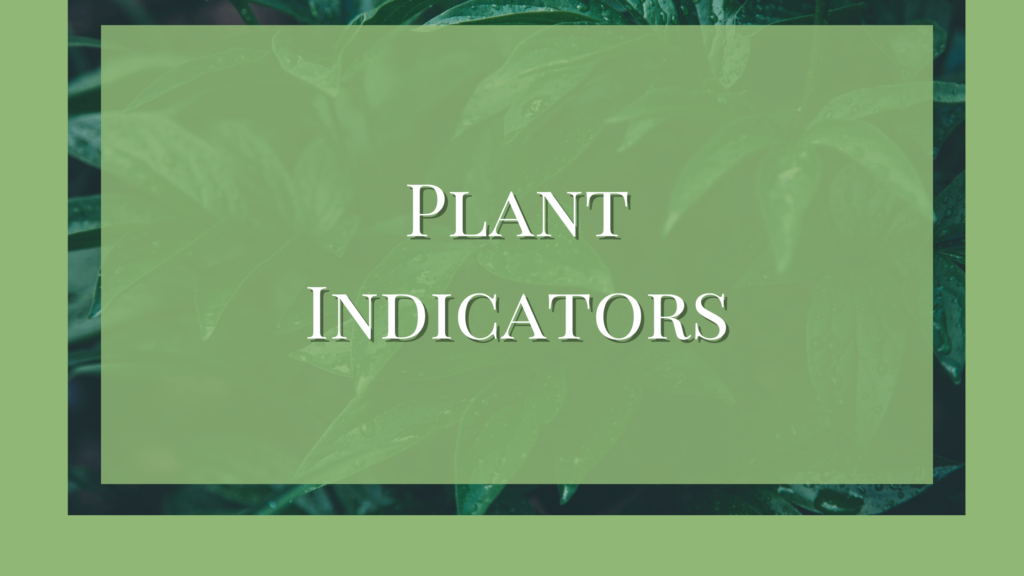Even though many plants grow in an area due to their wide tolerance, some species or ecotypes prefer niches with specific habitat conditions where the competition is minimal. These specific populations and communities that grow under specific environmental conditions are called biological or ecological indicators.
Plants that are used as indicators of specific habitat conditions are called plant indicators. Every organism is more or less the product of the condition in which it grows and therefore it is a measure of the environment. Ecologists constantly employ organisms as indicators in exploring new situations and evaluating large areas.
Plants are especially useful in this regard. The species and the morphology of plants growing in certain areas can provide valuable clues about the occurrence of minerals and metal-bearing deposits beneath the surface.
Benefits of Plant Indicators
Plant indicators can help identify various characteristics of the environment such as soil quality, air pollution, water quality, etc. Some of the common soil characteristics that plants can indicate include,
- Nutrient level of soils
- High or low nitrogen content
- Soil pH
- Water and moisture content
Different Types of Plant Indicators
Agriculture Indicators
A natural growth of only short grasses indicates that either the soil is thin or the availability of water is low. The natural growth of both tall and mixed grasses is a useful indicator of good fertile soil that can be profitably used for agriculture.
Plant Indicators of Groundwater
Certain plant communities indicate the depth of groundwater. The Central Arid Zone Research Institute in Jodhpur uses certain plants to indicate the depth and salinity level of groundwater. These plants usually belong to the family Chenopodiaceae.
In India, the common members of this family are Atrilen, Sauduea, etc. The presence of Hydrilla, Verticillata, and Ceratophyllum species indicates hard water. A few examples of plant communities that indicate the depth of available groundwater are given below.
- Acacia indica, Prosopis cineraria, Salvadora oleoides 12 – 20m
- Acacia senegal, Anogeissus pendula 12 – 18m
- Capparis decidua 12 – 20m
- Crotalaria burhia, Leptadenia pyrotechnica 6 – 20m
- Euphorbia caducifolia 12 – 18m
- Panicum turgidum, Polygonoides calligonum 6 – 18m
- Panicum turgidum, Zizyphus complex 6 – 18m
- Prosopis cineraria, Zizyphus nummularia, Capparis decidua 6 – 18m
- Salvadora oleoides, Capparis decidua 6 – 12m
- Salvadora oleoides, Prosopis cineraria 10 – 20m
- Salvadora oleoides, Zizyphus nummularia 18 – 28m
- Salvadora persica, Tamarix sps. 6m
- Suaeda fruticosa, Aleurophus lagopoides 6m
Plant Indicators for Overgrazing
Many plants are overgrazed which results in the modification of grassland. Overgrazing removes certain grasses while other plants are disturbed.
However, some vigorous and undisturbed plants remain viable and become distinct from the rest of the plants. Some plants show characteristic indications of overgrazing which can be recognized.
The predominance of annual weeds and short-lived perennials indicates severe grazing. Examples of such plants are Polygonum, Chenopodium, Vergena, etc. Some plants like Opuntia and Grindelia show poor or no overgrazing.
Plants as Indicators of Rock Types or Rockbed
In Rajasthan Calotropis, Drosera and Aerva grow together luxuriantly on gypsum beds. Euphorbia antiquorum grows on a granite-gennis complex in South India. Limestone beds contain better growth of Taxus, Bacata, etc. Sandstone beds are indicated in Texas, USA by Pinus taeda. Similarly, beds of igneous rocks support Becula, Salix, etc in Russia.
Mineral Indicators
Many plants grow in areas that are rich in minerals such as zinc, copper, cobalt, selenium, sulfur, etc and these plants are called metallophytes. The following plants grow in the presence of specific metals.
- Diamond: Vellozia candida in Brazil.
- Gold: Equisetum arvens, Peppaver livonoticum, Alpinia speciosa, Thuja sps.
- Silver: Perigonium ovalifolium in USA.
- Mercury: Stellaria setacate in Spain
- Uranium: Astragalus sps, and Neptunia.
- Cobalt: Crotalaria cobalticora.
Fire Indicators
Some plants are well adapted to grow in burnt and highly disturbed areas. Examples of such plants are Epilobium sicateum, Pteris aquilina, and the fungus Pyronema confluens.
Plant Indicators for Petroleum Deposits
Some protozoans such as Fusilinds indicate petroleum deposits.
Plant Indicators for Pollution
There is enough evidence to show that various pollutants do and continue to affect life on Earth. The harmful effects of various pollutants on humans, animals, plant life, and even the environment have been recognized.
Air pollution affects plants in two ways. First, it is by disturbing physiological processes thereby influencing their growth, productivity, etc. This will lead to the formation of stunted plants. The second way it affects is by causing visible damage due to high concentrations of pollution.
The air pollutants designated as plant indicators are toxic substances like sulfur dioxide, hydrogen fluoride, ozone, peroxyacetyl nitrate, hydrocarbon pollutants, etc. Lichens are one of the best indicators of air pollution as they are sensitive to toxic gases. In Germany, Parmelia physodes are used as an indicator to eliminate sulfur dioxide and hydrogen sulfide in the air.
Similarly, Utricularia sps, Otelia sps, Chara, Wolfia, etc., are used to assess the presence of water pollutants.
References
- Shukla, R.S. and Chandel, P.S. (2001) Plant Ecology. S. Chand and Company Ltd., New Delhi.
- Verma, P.S., Agarwal, V.K. (1999). Cell biology genetics molecular biology evolution and ecology. New Delhi: S.Chand Co.(Pvt) Ltd.
- Indicator plants: what are they & what can they tell us?





Plant indicators, like bioindicators and sentinel plants, provide crucial information about environmental conditions. They help monitor soil health, pollution levels, and ecosystem changes. Utilizing these indicators supports effective environmental management. #PlantIndicators #EnvironmentalMonitoring #Sustainability